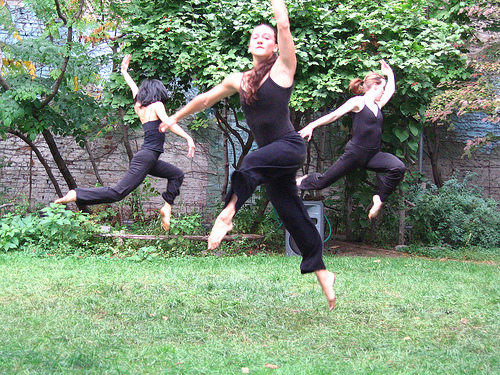[photo: Pi Dance Theatre, Sept. 2007]
In 1984, the Clinton Community Garden became the first community garden in New York City to be granted permanent parkland status. This was a big moment both for our garden and the future of community gardening in the city. The story of our garden, however, starts some seven years earlier when a group of residents on West 48th Street decided to do something about the garbage heap in the middle of their block. Abandoned for 28 years, the lot held the remains of two tenement buildings, rusted-out cars, and ever-growing piles of trash, and was generally a magnet for illegal activity in a neighborhood that had its share of crime and misery. But the neighbors spotted some wild tomato plants growing out of the rubble and saw a chance for something else.
The city-owned property was leased through Operation GreenThumb in 1979 and organized into two sections, a public front garden with a lawn and flower beds and a back area for individual plots. Over the next several years, the back garden was expanded from the west to the east, so that 108 garden plots were eventually created. Paths were built from salvaged brick, and fences and gates were put in to protect the garden and separate the public area from the plots in the back. Stone benches were made from recycled slabs of slate and concrete blocks. In the early days, the garden featured a geodesic dome for winter gardening, and a mural, the mirror image of the garden, was painted on the building wall on the west side. Traces of this mural, by Mallory Abramson, a prominent garden founder and leader, are still visible today behind the Native American bed. The open green space stood in miraculous contrast to the then nearly tree-less block, offering escape from cramped apartments. The few nearby parks at the time stood in disrepair. Hell’s Kitchen Park, around the corner, had plenty of asphalt, concrete, and pigeon droppings but little greenery.
Despite, or because of, the garden’s success, the city announced its intention to auction off the 15,000-square-foot piece of land in 1981. Developers had begun to turn their attention to Hell’s Kitchen, viewing long-neglected buildings and lots as prime real estate, and the city was anxious to collect revenue on such properties. This was, of course, symptomatic of what communities were experiencing throughout the city and many gardens were perishing as a result. The community united to halt the sale, forming the Committee to Save Clinton Community Garden, and launched the Square-Inch Campaign. The idea was to secure the garden, which had been assessed at $167,000 and advertised for $375,000 in the city’s auction guide, by “selling” a piece of it for a $5.00 donation. The Trust for Public Land, Housing Conservation Coordinators, and the Green Guerillas joined in the fight. The story attracted national attention and ultimately won the support of Mayor Edward Koch, who kicked off the campaign in April of 1984 by buying the first square inch. The Square-Inch mural (it’s a giant segmented worm) on the garden’s east side, also by Mallory, marked the campaign’s progress, becoming greener as donations grew.
